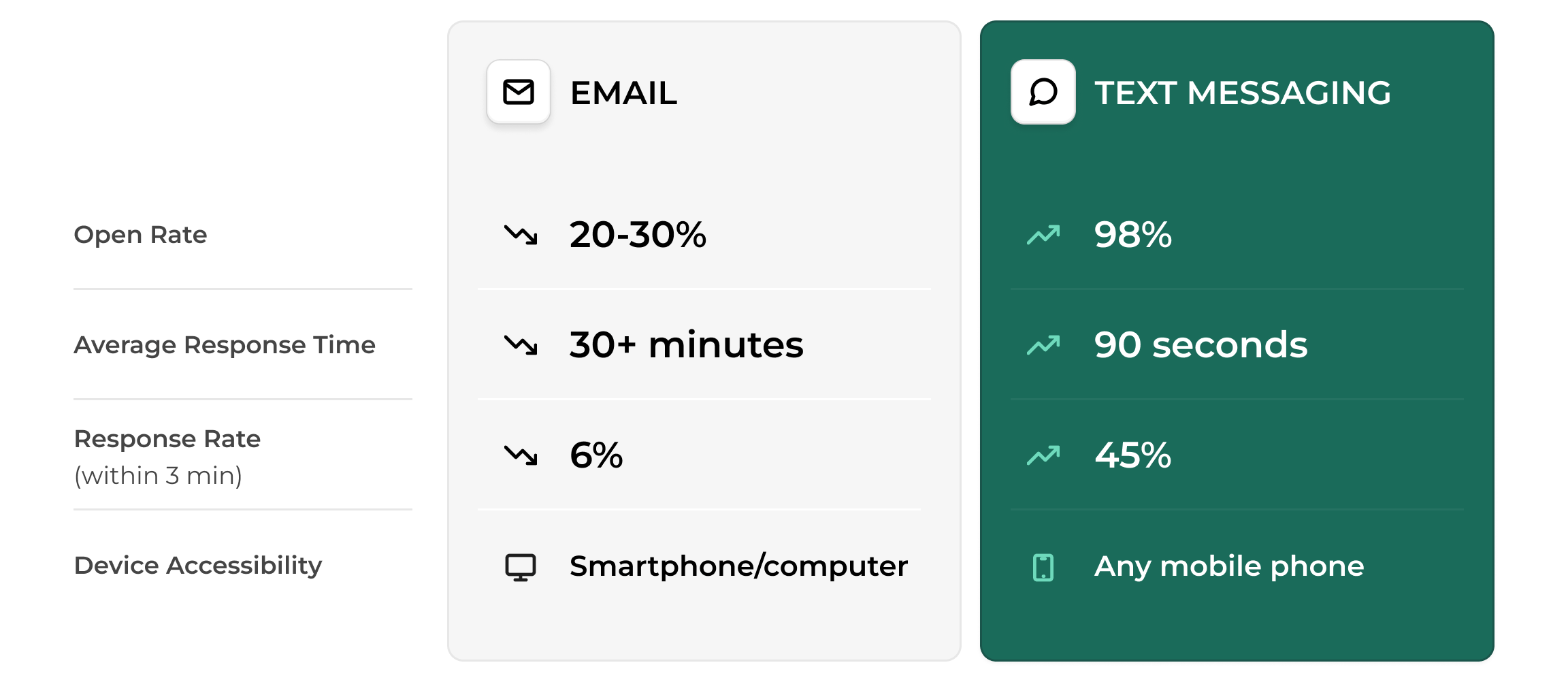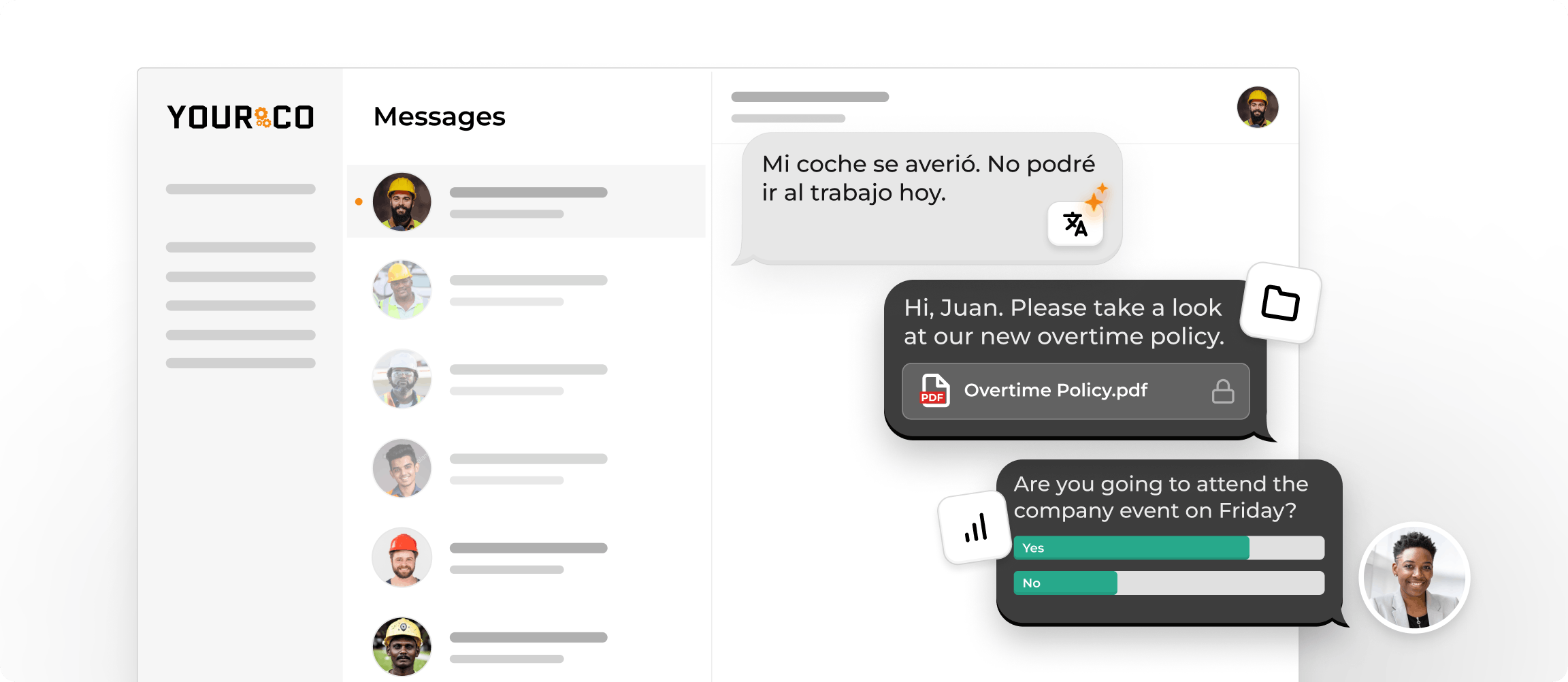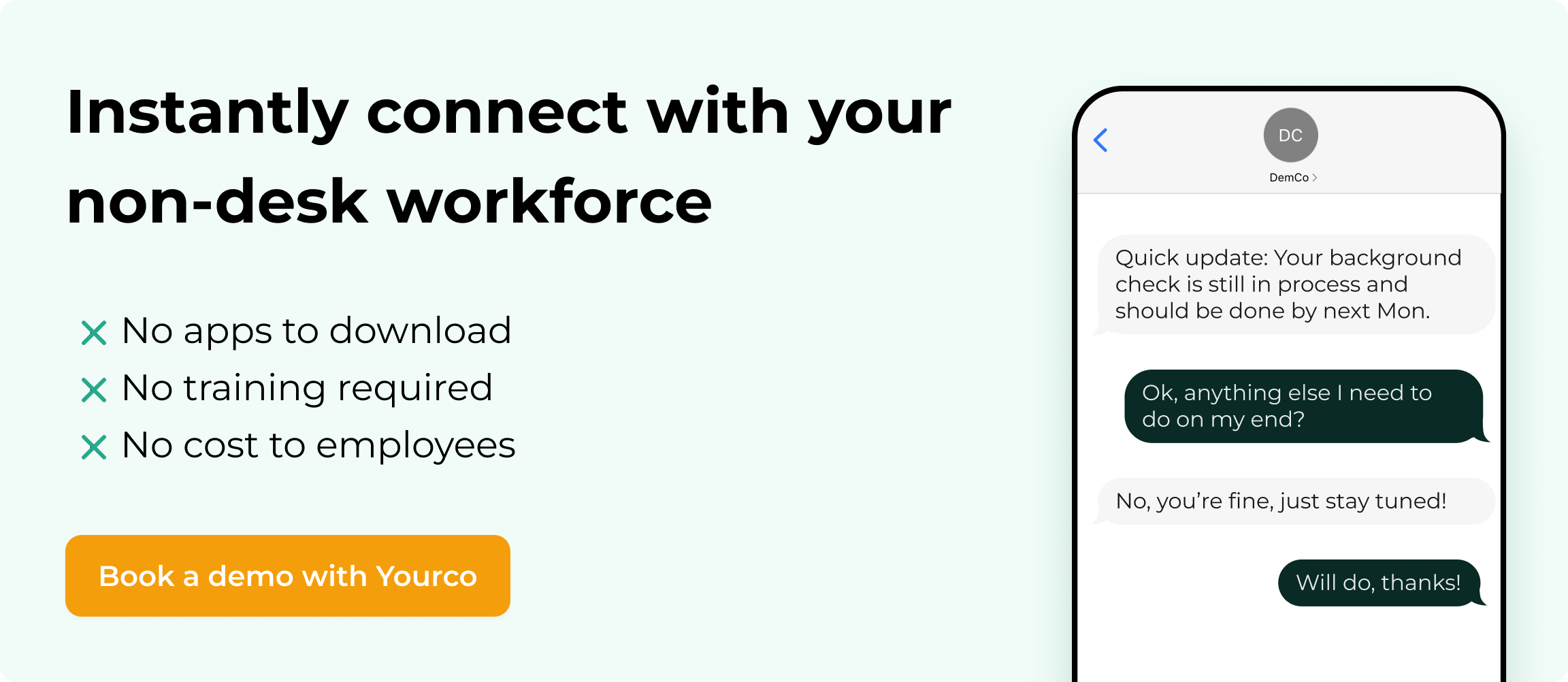Texting vs Email in the Workplace

Texting vs Email in the Workplace
When something urgent happens, waiting for employees to check their email isn't an option. Frontline employees face an even bigger hurdle: they often work in environments without internet access or may not have email-capable devices, making it nearly impossible to reach them through traditional channels.
Work-related text messages reach employees almost immediately, solving the email problem. Many frontline employees don't even have company email addresses, making texting not just faster, but often the only reliable option. You can also schedule text messages to reach your team at optimal times.
But what are the advantages and disadvantages of text messages in business? What about email? It's often said that email is more professional, but text messaging doesn't have to be an unprofessional form of employee communication. So what's the real difference between email and text? We will explore the two and their different purposes within business operations.
What Is the Difference Between Email Writing and Text Message?
As a manager or HR employee, having access to workers in an instant is essential, especially when it's urgent. Users can send and receive short messages by using a mobile device that supports text messaging, or send messages and data via email.
But what is the difference between text messages and email messages? Here's how they compare:
- Internet connection vs. cellular connection
- Long form vs. short form
- Email client vs. standard phone
While both email and SMS are important forms of employee communication, they work best in different situations. Emails work well for office settings and long-form content, while texting works better for non-office settings or urgent matters. However, texting and email both serve the same purpose: to promote communication between the sender and the recipient through messaging information.
Here's a quick comparison of key performance metrics between email and text messaging:
- Open Rate: 20-35%
- Average Response Time: 30+ minutes
- Response Rate (within 3 min): 6%
- Device Accessibility: Smartphone or computer required
Text Messaging
- Open Rate: 98%
- Average Response Time: 90 seconds
- Response Rate (within 3 min): 45%
- Device Accessibility: Works on any mobile phone
These statistics highlight the superior engagement and responsiveness of text messaging, making it a more effective channel for reaching frontline employees quickly.
Text vs Email: Does It Really Matter?
Beyond the differences, many people might question the similarities between email and text messages. Texts and emails are really only similar in the sense that they are text-based forms of communication that employees, managers, HR, and other workers use to relay information.
Is Email More Professional than Texting?
In short, no. Many team members and managers would say that email is the most professional way to communicate in an office setting with customers and others in the company. Because texting is less common in office settings, typically people consider it to be less professional. One reason emails are typically a primary way of communicating is they leave a "paper trail" of communication. If any issues were to arise, emails help businesses keep track of any ongoing discussions or issues.
However, what counts as professional depends on where people work. While desk employees typically have a company email address, non-desk employees might not have email access and, therefore, texting is the most appropriate form of employee communication. Texting can be professional when you use it properly, like communicating any policy updates, weather concerns, or workplace hazards. It all depends on the company, the texting solution used, the employee's position, and the situation in which managers and HR are communicating with their employees.
Implementing text messaging requires attention to privacy and compliance requirements. Fortunately, Yourco handles all processes in regard to privacy and compliance for our clients. We also proactively monitor Yourco accounts to ensure they remain in compliance and good-standing with the phone Carriers over time.
So while email might be the go-to communication for office employees, texting doesn't have to be unprofessional. In fact, software solutions like Yourco make texting your employees important information simple. It keeps a paper trail of texts in the interface, so you always have access to previous conversations. You'll also be able to keep track of any issues and address them accordingly.
Some industries that could benefit from texting more than email include:
No matter what the job is, texting can be a great way to communicate with your team.
Why Texting Is Good for Communication With Diverse Workforces?
Because most individuals have their phones with them, texting is a quick and easy way to communicate. Texting is one of the best ways to communicate, because to put it plainly, people read their texts. In fact, 98% of text messages get opened, and a significant amount of texts are answered in as little as 90 seconds. Therefore, when you send a text message, the likelihood that your message will be read and responded to is very high. Texting is especially useful when there is no time to waste or when an employee can't be reached via email.
For businesses, texting can keep employees informed when they're away from a desk or in the field. Not only are they likely to read texts quickly, but they can also access them from almost anywhere, even without an internet connection. Appointment scheduling, emergency alerts, and reminders may all be managed by texting, which gives businesses an advantage in their communication with employees. Because of how simple and fast texting can be, it is an ideal way to contact employees while they're working.
For example, if an employee is working at a construction site, texting them about potentially hazardous weather conditions helps keep them aware of the situation, so they can take precautions and stay safe. Or, if the warehouse has a hazardous chemical spill, a text message can let your employees know to stay away from the area until it is safe. In these cases, texting works best for communicating with employees.
Text messaging is valuable for various critical communication needs, including:
- Emergency alerts and safety communications
- Event coordination and scheduling updates
- New hire communication and onboarding processes
- Quick feedback collection and surveys
- Operational updates and shift changes
The platform's strength lies in its ability to reach employees regardless of their location or access to traditional communication tools like email or intranets.
Text Messages Advantages and Disadvantages
The advantages of text messaging in employee communication far outweigh the disadvantages, but let's explore the reasons why:
Advantages of texting include:
- Near instant communication
- Higher visibility and open rate
- Big reach with group/mass texting
- Can be scheduled or automated
- Every cellphone has texting capabilities
- Cost-effective
- Only contact who is necessary
- Reliable
- Broader accessibility for frontline workers
Disadvantages of texting include:
- Viewed as unprofessional for desk workers
- Needs to be brief and conversational
While it might be hard to discern tone and body language through texting in some instances, being able to communicate instantly with higher open rates and reliability are incredibly beneficial for businesses trying to reach their employees. Of course, in moments of urgency, texting is an advantageous technology.
Using Yourco, you can text message your employees no matter where they are. Our simple interface keeps all of your messages accessible in one place. Whether you need to inform your team of the next assignment or of extreme weather (and everything in between), you can rest assured that Yourco will be a helpful solution to reaching employees in an instant. Yourco also solves group text confusion by sending individual messages, even if they're addressed to the whole team.
Why Is a Text Message Better than an Email?
Unlike email, text messages can reach your employees without an internet connection. They don't even need to have a cellular data plan to send and receive SMS! Combine that with the fact that the overall average open rate of emails is 35% compared to 98% of text messages, and you'll see why texting can be a more effective and efficient form of communication. Beyond that, many see email as the old-school professional way to reach employees and colleagues, but you can never be sure how long it will take the recipient to see the message. The time spent waiting is especially taxing if they're away from their desk or without internet access. On the other hand, all phones have texting capabilities, which means employees can be reached no matter where they are.
Is Texting Professional Communication?
Texting can be just as professional as email when you use the right tools and approach. For frontline teams, it's often the most effective way to stay connected.
It could be argued that, because texting is more efficient, it's better to contact employees for anything that needs to be addressed quickly. When employees are in the field, texting works best.
Using a solution like Yourco gives you the ability to contact employees in bulk or individually, without creating a massive group chat where important information gets lost. With texting capabilities all in one easy-to-use dashboard, businesses can reach their employees using software rather than an actual phone. This means it's easier to keep track of conversations and reach employees more effectively.
When Is Email Appropriate for Communication?
In business, office workers typically use email for everyday discussions about projects and sharing information like contracts, presentations, or files.
Why Would Someone Email Instead of Text?
If you're wondering, "Why would someone send an email instead of calling or texting?," the answer often depends on the type of worker and their daily access to email. Email remains the primary method of communication for office-based employees who work at a desk, providing a structured way to share detailed instructions, complex updates, and important documents like contracts and reports. For white-collar employees, email is essential for formal documentation and long-form communication that requires attachments, version control, or compliance tracking.
However, for frontline workers in industries like manufacturing and construction, email is far less practical. Many of these employees do not have company-issued email addresses or regular access to a computer, making email an unreliable method for urgent updates. Instead, real-time communication tools like Yourco offer a more effective way to reach workers who are on the move, in the field, or on the production floor. Unlike email, texting through Yourco enables instant access to critical updates without requiring an internet connection or a dedicated email account.
For example, if there is a policy change that includes an attachment outlining the updates, email would be a logical choice for white-collar employees who can review and reference the document on their computers. However, for non-desk workers, a text message with a link to access the file later ensures they still receive the information without delay. Choosing texting as the primary means of professional communication in these environments ensures accessibility for all employees, not just those working at a desk.
Texting through Yourco provides operational texting capabilities, including:
- Company Announcements
- Benefits Communication
- Employee Alerts
- Employee Surveys
- Onboarding Employees
- Employee Referrals
- Call-Off Line (Text-Off Line)
While offices will continue to rely on email for structured communication, texting serves as a crucial tool for industries where immediate, on-the-go communication is necessary to keep all employees informed without messages getting lost in an overflowing inbox.
ROI and Business Impact of Switching to Text-Based Communication
Switching to text-based communication delivers clear returns across multiple industries, with measurable impacts on both operational efficiency and your bottom line.
Employee Satisfaction and Retention Impact
The impact on workforce satisfaction and retention is noteworthy. Organizations with effective text-based communication systems saw improvements:
- 70% of employees prefer text communication
- Companies experienced a 15% increase in employee morale
- Organizations achieved a 10% decrease in turnover within the first year
Bottom-Line Business Results
The financial impact of improved communication is substantial. Better employee experience through improved communication results in a 45% increase in profits per person-hour. Highly engaged organizations achieve a 23% difference in profitability and a 43% improvement in turnover rates compared to less engaged counterparts.
These improvements matter because 81% of IT leaders report being under pressure to defend their technology investments and prove ROI. Text-based communication solutions not only justify their cost but deliver substantial returns through improved efficiency, employee satisfaction, and bottom-line results.
For organizations looking to improve their communication strategies, implementing a text-based solution can deliver measurable business value across multiple departments and operational areas.
Reach Your Employees Anywhere with Yourco
If you'd like to contact your frontline employees when they're in the warehouse, on the plant floor, or out in the field, all you need is Yourco. We eliminate the hassle of texting your employees with an easy-to-use software solution. Find all of your company text messages in one place, and don't worry about cluttered group texts.
You can send out mass messages to your team while keeping each discussion separated. Don't send an email and hope it reaches them; send out a text and get a hold of them immediately. Whether it's urgent information or a brief update, using Yourco to text your employees is the best way to communicate.
Yourco also offers advanced features that go beyond basic texting, including AI-powered translations to connect with multilingual workforces, built-in surveys for gathering feedback, and secure document sharing capabilities. These features make Yourco the complete solution for frontline employee communication.
To try Yourco, contact us to set up a demo, or try it out for free today.
Frequently Asked Questions
Can text messaging really be considered professional in a workplace setting?
Yes, text messaging can absolutely be professional when used appropriately. The key is context and implementation. For frontline workers in industries like construction, manufacturing, and logistics, SMS is often the most professional and effective communication method available. With proper SMS platforms like Yourco, businesses maintain professional standards through features like message logging, compliance tracking, and administrative oversight.
How do you ensure compliance when using text messaging for employee communication?
Compliance is managed through several key practices: obtaining explicit employee consent before sending messages, implementing proper opt-in and opt-out procedures, maintaining message records for audit purposes, and following industry regulations like GDPR and TCPA. Professional SMS platforms handle these compliance requirements automatically, reducing the burden on HR teams while ensuring legal protection.
What happens if employees don't have smartphones for text messaging?
Text messaging works on any mobile phone, including basic flip phones. Unlike mobile apps or email that require smartphones and internet access, SMS functions on all cellular devices. This universal accessibility makes texting particularly valuable for reaching diverse workforces, including employees who may not have or want to use smartphones for work purposes.
How does text messaging compare to email for document sharing and detailed information?
While email excels at sharing detailed documents and long-form content, text messaging can effectively complement this by providing links to documents, brief summaries, and urgent alerts about important information. Modern SMS platforms allow for secure document sharing through protected links, ensuring employees can access necessary files while receiving immediate notifications about their availability.
Can text messaging integrate with existing HR and communication systems?
Yes, professional SMS platforms typically offer extensive integration capabilities with HRIS, payroll systems, scheduling software, and other business tools. These integrations allow for automated messaging based on system triggers, synchronized employee data, and streamlined workflows that reduce manual administrative work while improving communication effectiveness.





